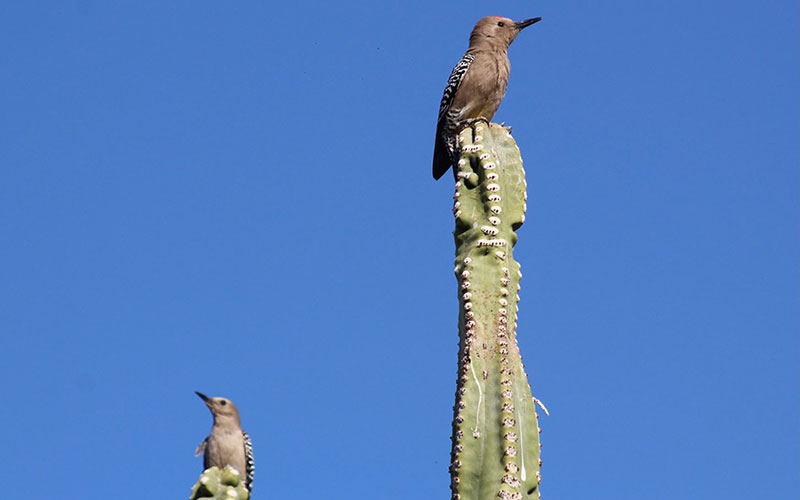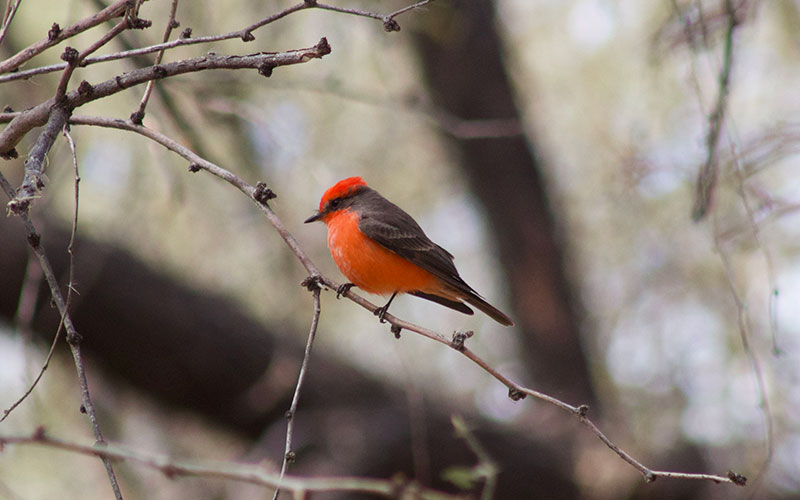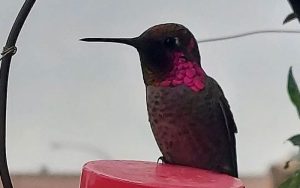
The wide-ranging Gila woodpecker is one of hundreds of bird species that call central Arizona home. (Photo courtesy of Tahiry Langrand)

Vermilion flycatchers are among the more than 500 bird species found in Arizona. During this month’s Great Backyard Bird Count, citizen scientists observed and shared their sightings using the mobile app eBird. (Photo courtesy of Tahiry Langrand)
MESA – Verdins. Red-tailed hawks. Hummingbirds. Quail. Roadrunners. Lesser goldfinches. These are just a few of the birds Lisa Ullman sees when she looks over the backyard of her home in Mesa.
Ullman, a former special education teacher, and her family planted native plants in 2017. By the next year, when the plants started to bloom and go to seed, they attracted some visitors.
“We had every native bird. We had insects. We had praying mantises. And we started to get butterflies, too,” Ullman recalled. “We really got into birding when things started to bloom.”
Since then, Ullman has embraced the hobby, and so far has spotted 61 species across Arizona, including a lot of hummingbirds that come to her feeders.
“I name them, too!” Ullman said. “We have Lois. We have Maurizio. We’re on the third or fourth generation that we know they’re the offspring of the previous generation. Lois was the matriarch that first came to the feeder.”
Ullman and her husband started tracking their bird observations seriously in 2019 on eBird, an app that allows birders to create checklists of their sightings that include photos and location data.
“We did eBird’s Global Big Day back in 2020,” Ullman said. “That was the first time we seriously reported on the eBird app.”
A “big day” event is one in which birders try to observe and report as many species in one day as possible. The eBird Global Big Day is a citizen science event that connects birders all over the world as they report their findings on the eBird app.
This year, Ullman and her family participated in another citizen science project on eBird, called the Great Backyard Bird Count, a four day birding event that gives scientists a real-time snapshot of where birds are across the world.
This is Ullman’s first Great Backyard Bird Count.

A few years ago, Lisa Ullman of Mesa converted her backyard to native plants and soon noticed native birds visiting the space. Since then, she’s become an avid birder. (Photo courtesy of Lisa Ullman)
“We’re all really into it and we see the value of it to the neighborhood,” Ullman said. “We see the value of it in our lives to pay attention to what’s going on and how we can be a part of protecting it.”
The count is a partnership between the Cornell Lab of Ornithology, the National Audubon Society and Birds Canada.
This year’s count, from Feb. 18 to 21, marked the event’s 25th anniversary. Seasoned and fledgling birders alike took to their backyards, neighborhood parks, nature preserves and the wilderness to spot birds and share their sightings with scientists, mainly through the eBird and Merlin Bird ID apps, which are managed by the Cornell Lab of Ornithology in Ithaca, New York. The data from this year’s count will be summarized and released in early April.
Mid-February is a unique time for scientists observing bird species because it marks a little pause in the global movement of birds, said Tice Supplee, the director of bird conservation for Audubon Southwest.
“This is the tail end of the wintertime for our North American species. Some are birds that winter or summer and nested in Canada and are here in Arizona,” Supplee said. “Arizona is a winter town for them. They’re going to migrate north next month.”
The four-day backyard count uses the gathering of data by the public to give scientists a real-time global snapshot of birds right before a major migration period in the spring months, she said.
eBird is one of the top citizen science tools that people around the globe are using to enter bird science data throughout the year, including during the GBBC, said Becca Rodomsky-Bish, the project leader for the backyard count.
“GBBC data all goes into eBird, but they didn’t create eBird until they saw how successful GBBC was and said, “Hey, maybe we can make a tool or we can make this easier for people and actually gather more data,’” Rodomsky-Bish said.
Since then, it has “exploded,” she said. “Researchers use it all the time. There were 142 publications using eBird data last year alone. So it’s a very powerful conservation tool.”
Scientists put the birders’ data into an enormous database, where researchers take a close look at it after the count concludes. Citizen science bird counts through eBird are helping to reveal trends.
One of those trends is that birds are not flying as far south anymore and are spending the winters farther north in places like Arizona. Rodomsky-Bish and Supplee both said this is an indication of how climate change is affecting the range in which birds can access food and habitat resources. These changes are being looked at on a species level.
“Birds are informers because they are like any other organism, they’re going to go where they need to go to survive,” Rodomsky-Bish said. “And if they don’t need to fly as far south to get the resources that they need, they won’t. They’re not going to expend that energy. Migration is one of the biggest energy expenditures for birds, and it’s one of the most dangerous things that they do.”
According to the Arizona Game & Fish Department, Arizona has 534 bird species, 48 of which, like the Arizona woodpecker and red-faced warbler, are highly vulnerable and will face additional stresses as the climate changes.
Supplee said the GBBC also provides valuable information about how bird populations that stay year-round in Arizona are doing.
“This allows us to document some birds adapting to our city environments,” she said. “Just look at a little bird called the verdin, which is a cute little bird with a yellow head. Data for that bird indicated that it’s numbers were declining, but now it’s showing up in really good numbers in our cities, particularly where people are planting native trees, like palo verde.”
Supplee, who lives in downtown Phoenix, said she’s optimistic about the state of native birds in urban areas because maintaining native vegetation as Phoenix continues to develop will help keep their habitat from shrinking.
“Look at the cactus wren, which thrives in areas with native cacti,” she said. “That’s the bird I don’t see much in central Phoenix, or in many new developments because nobody plants cholla cactus. If I go out into the areas where people still have native plants, there are cactus wrens. We can help them out by what we choose to plant natives in our yards. I like to suggest the cholla cactus are great ways to attract native species and deter burglars.”

Lisa Ullman, who this month participated in her first Great Backyard Bird Count, enjoys watching birds from her backyard in Mesa. She names many of them, including this Anna’s hummingbird she calls “Maurizio.” (Photo courtesy of Lisa Ullman)
Ullman said the Great Backyard Bird Count helps with understanding trends with bird populations, and it encourages backyard birding, which levels the playing field for people of all colors and genders and backgrounds.
“As a Hispanic woman, I don’t know that I’ve ever really felt welcome in a lot of outdoor communities,” she said. “I feel like it’s more inclusive where you can do it within the privacy of your home. I think that it has allowed me a little bit more freedom, and I feel like I can be a little bit more part of science in nature without the hindrance of feeling like I’m not being included. I think it’s a much more inclusive way that anybody can participate.”
Tahiry Langrand, a sustainability major and vice-president of Sun Devil Audubon at Arizona State University, echoed Ullman’s thoughts.
Like any other hobby, Langrand said, birding can be expensive with gear and travel. But events like the backyard count bring local communities together around conservation efforts.
“In terms of backyard biodiversity, I think there’s something striking about realizing what’s in your immediate whereabouts. There’s also accessibility,” Langrand said. “You don’t have to travel to Brazil to see amazing birds. If people realize what is around them, then they’d be more open to protecting it or preserving it.”


